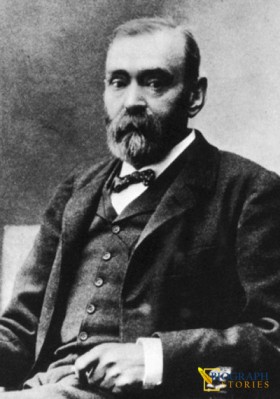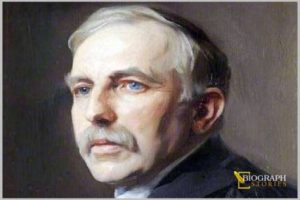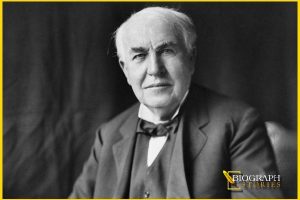
Alfred Nobel Quick fact:
Born: 21 October 1833, Stockholm, Sweden
Died: 10 December 1896 (aged 63), Sanremo, Italy
Resting place: Norra begravningsplatsen, Stockholm, Sweden
Monuments: Nobel Monument
Nationality: Swedish
Occupation: Chemist, engineer, inventor, businessperson, philanthropist
Known for: Benefactor of the Nobel Prize, inventor of dynamite
Net worth: $250 million
Parent(s): Immanuel Nobel, Andriette Nobel
Relatives: Ludvig Nobel, Emil Oskar Nobel, Robert Nobel
Biography of Alfred Nobel:
Swedish inventor, engineer and industrialist Alfred Bernhard Nobel who had obtained a total of 355 patents in his lifetime. He was most famous for inventing dynamite, and for developing some more powerful explosives and detonators to effectively ignite them. With almost a hundred factories all over the world, he built a network to manufacture explosives and ammunition, and amassed a massive fortune from his businesses. In fact, he was one of the wealthiest persons on the world at the time of his death. There were many speculations about the contents of his last will that he had signed on 27 November 1895 because he was unmarried and childless.
His much hopeful extended family disappointment because of contents of his will as Nobel had left much of his wealth for the establishment of an international prize fund. He had earned sobriquet, ‘The Merchant of Death’ as he was the inventor of dynamite and that deeply traumatized Nobel who was a pacifist at heart. In order to redeem his posthumous reputation, he left the major portion of his wealth for the establishment of the Nobel Prizes to be awarded for eminence in five different fields, without any discrimination on basis of nationality. Because Alfred Nobel did not want to be remembered as the reason behind mass destruction after his death.
Childhood & Early Life of Alfred Nobel:
Alfred Bernhard Nobel was born on October 21, 1833, in Stockholm, Sweden. He was born to Immanuel Nobel and Karolina Andriette Nobel. The couple had eight children together but only Alfred and three of his brothers survived to adulthood while the other children perished. His father Immanuel Nobel was an inventor and engineer. He was struggling to set up a profitable business in Sweden. When Nobel was 4 years old, his father moved to St. Petersburg, Russia and after unsuccessfully trying to establish a business for years, finally he was successful in opening a business producing machine tools and explosives. Alfred’s parents engaged private tutors to educate him and he excelled in his studies.
Nobel was often sickly as a child, but he was always lively and curious about the world around him. Soon he became fluent in English, German, French and Russian. He especially loved chemistry and languages. He went to Paris in 1850 and studied under the chemist Nikolai Zinin. Such was his love for chemistry that he went to the U.S. as an 18 year old to further his knowledge on the subject. In 1857, he filed his first patent—for a gas meter.
Later Years of Alfred Nobel:
After completing his studies, he started working in his father’s factory. The factory came under the control of his brother Ludvig in 1859 and thrived under him. Alfred was deeply interested in studying explosives and experimented with nitroglycerine, a highly explosive compound. In 1864, when Nobel was 29, a huge explosion in the family’s Swedish factory killed five people, including Nobel’s younger brother Emil. This incident made Nobel more focused on developing explosives that were safer than nitroglycerin.
He found through constant experimenting that when nitroglycerin was combined with an absorbent inert substance, it became more convenient to handle and safer to use. In 1867, this new substance, dynamite, was patented and adopted in wide usage in mining internationally. It was stronger than black powder and the first safely manageable explosive. He mixed nitroglycerin with nitrocellulose compounds to continuing his fascination with nitroglycerin and developed a transparent, jelly-like substance which was even more powerful than dynamite. It was patented in 1876 and called gelignite. Gelignite was better for mining and more stable. This invention helped him to earn a great deal of wealth.
He formulated a smokeless propellant made from nitrocellulose and nitroglycerin that also contained 10% camphor. In 1887, this mixture was patented and called ballistite. In 1888, his brother Ludvig died in Cannes. A French newspaper erroneously published Nobel’s obituary stating; “The merchant of death is dead” instead of Ludvig’s and condemned Nobel for his invention of dynamite. Alfred was highly upset to realize that this was how he would be remembered after his death. To redeem his reputation he wanted to do something. He left a major portion of his massive wealth for the creation of an international prize fund for honoring eminent personalities in the fields of physics, chemistry, medicine, literature, and for work in peace. Signed on 27 November 1895, his last will laid the foundation for the prize. The first Nobel prizes were awarded in 1901.
Personal Life & Legacy of Alfred Nobel: Alfred Nobel never married or had children, and was a loner who suffered from bouts of depression. However, he fell in love with a Russian girl called Alexandra who rejected his proposal. Later, he developed feelings for his secretary Bertha Kinsky and he had a close friendship with her until his death. In 1876, he met Sofie Hess and developed a relationship with her that lasted for 18 years. From a young age, he loved literature and used to write poetry. He never got his work published because His parents were opposed to his literary pursuits. Lifelong he had been working in proximity to explosive substances that greatly affected his health. In 1896, he died of a stroke.







